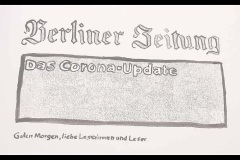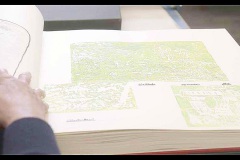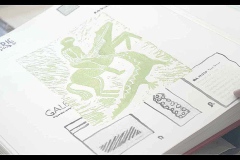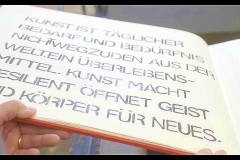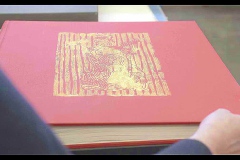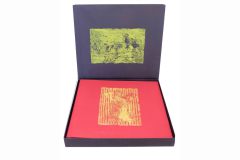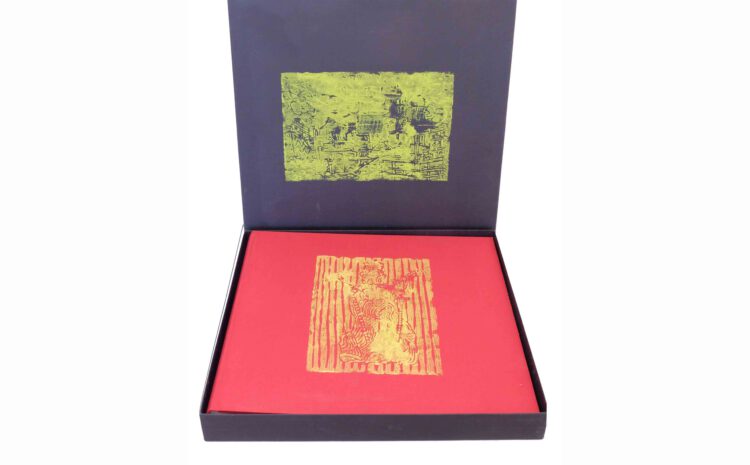
The Corona Diary: Acquisition by the Cologne Art and Museum Library
SAVE THE DATE
On March 15, Nele Ströbel will give a lecture at 7 p.m. in the Art and Museum Library of the City of Cologne (in the Museum Ludwig, Heinrich-Böll-Platz, Bischofsgartenstr. 1, 50667 Cologne), will present her Corona diary as part of the “Art with Books” program. This was purchased by the KMB in 2022. In addition to the presentation of other artists’ books, there will also be an artist talk on this evening
Nele Ströbel,
Corona Diary
, 2020/21, 60-page codex (linoleum prints and frottages) in slipcase
48 x 48 x 8 cm, © Nele Ströbel / VG Bild-Kunst, Bonn 2022
We are very pleased that the City of Cologne has purchased Nele Ströbel ‘s Corona Diary for the Art and Museum Library and would like to express our sincere thanks!
The large-format codex brings together linoleum prints made during the corona pandemic. Among them are city views of Munich and Berlin (in these cities the artist lives and works) and prints of the Holy Corona. The prints were supplemented “with texts and frottages of digital signs of life that reached me by email” (Nele Ströbel) as well as with very personal thoughts of the artist.
In the 2021 artist’s film by Nele Ströbel, you can look over the artist’s shoulder as she leafs through the Codex.
LINK WITH. Works-papeRWORKES LINOLCOLLAGES
Coronatagebuch Linoldrucke und Frottagen
NOTES ON “CORONA DIARY”:
At the beginning of the first lockdown, 2020 I had “still quickly” ordered a roll of linoleum online:
Article No. 23, Berlin red. The roll 2 meters wide, 5 meters minimum order quantity was delivered to the “curb”, unfortunately as so often these days, the shipping company had not called. The truck was just suddenly there, spitting out the heavy roll of precious linoleum.
Somehow I made it to the sidewalk and began rolling up, measuring, dividing, cutting and hauling away in the middle of downtown under the incredulous eyes of neighbors and passersby.
That was my survival treasure, driving on sight and carving for time. First the statue of St. Corona, according to legend a helper against the plagues, then many printing blocks Berlin and Munich after 45. Everything destroyed, only a few landmarks as silhouettes: the Memorial Church, the Residence, the Brandenburg Gate, the Museum Island.
I had always made linoleum prints, but never exclusively, it was like a pull. A friend of mine of many years only said that between the wars and after 45 many women artists had discovered linoleum as a medium for themselves. It came out of demolition houses, among rubble and ashes.
During a walk I met a young family. The tousled father, amused despite the times, was building a mountain of things behind a “To Give Away” sign on the sidewalk. When I stopped, interested, he pulled out a large, square cardboard box. He said it’s still available, too, and there’s a great book in it. He gave me a gigantic red bound photo album that contained 50 brand new pages of handmade paper and spider leaf dividers in. I stored the heavy thing in the bushes to carry it to its place of action on the way back.
This is how the CORONA DAYBOOK came into being. Linoleum hand prints from green tinting paint.
Partly watercolored, these were supplemented with texts and frottages of digital signs of life that reached me by email.
Due to a pandemic, I had to give up my Munich studio in 2020 and move everything to Berlin. While clearing out, a folder with printing blocks from the post-war period was found. Intrepid schoolchildren from the family had worked stories into the linoleum with knives and scissors. It was told from a world between mythical figures, country life and tanks. I have printed them as comments and signs of hope between my Corona motifs and texts. My spatial works are anchored in the architectural context in terms of content and form. I install linoleum prints on many different image carriers and always spatially.


